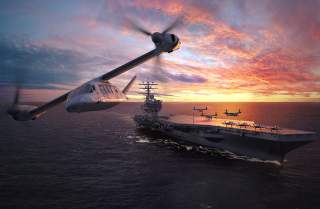U.S. Army's New Futuristic Helicopters Won't Be Like Anything You Have Ever Seen
Coming to a war near you--around 2030.
Weapons Systems:
JMR Weapons Systems Integration is a critical part of this effort. The JMR aircraft will be engineered to integrate weapons and sensor systems to autonomously detect, designate and track targets, perform targeting operations during high-speed maneuvers, conduct off-axis engagements, track multiple targets simultaneously and optimize fire-control performance such that ballistic weapons can accommodate environmental effects such as wind and temperature, Army documents on the aircraft have stated.
Automatic Avoidance:
Air-to-Air "tracking" capability is another solution sought by the Army, comprised of advanced software and sensors able to inform pilots of obstacles such as a UAS or nearby aircraft; this technology will likely include Identify Friend or Foe, or IFF, transponders which cue pilots regarding nearby aircraft, Army officials have said.
Technical solutions able to provide another important obstacle avoidance "sensing" capability called Controlled Flight Into Terrain, or CFIT, are also being explored; in this instance, sensors, advanced mapping technology and digital flight controls would be engineered to protect an aircraft from nearby terrain such as trees, mountains, telephone wires and other low-visibility items by providing pilots with sufficient warning of an upcoming obstacle and, in some instances, offering them course-correcting flight options.
Using sensors and other technologies to help pilots navigate through "brown-outs" or other conditions involving what's called a "Degraded Visual Environment" is a key area of emphasis as well, according to Army officials.
The Army is looking at a range of solutions such as radar, electro-optical equipment, lasers, sensors, software, avionics and communications equipment to see what the right architecture is and how we would integrate all these things together.
Progress Thus Far:
In addition to conducting the first official Army-industry flight of the two demonstrators, the program is working on a Material Development Decision, designed to pave the way for the FVL acquisition program. This effort conducts a thorough examination of all the available technologies and their performance through what is called an “analysis of alternatives.”
A key advantage of a joint FVL program is that it will engender further inter-operability between the services and, for example, allow an Army helicopter to easily be serviced with maintenance at a Marine Corps Forward Operating Base, Bailey explained.
Bell and Sikorsky-Boeing teams are both done with their subsystem critical design review and the components are in fabrication and safety flight testing, Bailey explained.
“Bell has a completed fuselage that is undergoing the nuances of getting landing gear attached to it and holes for wiring. They are complete with their wing build and they are just starting to make it to the engine itself,” Bailey said.
Bell engineers have been mounting the wing to the fuselage.
“It really is starting to look like major components to the aircraft. By May it will likely look like a complete aircraft but it will not have all the subsystems,” he added.
The Sikorsky-Boeing – fuselage is complete as well, Bailey said.
“The transmission, main rotor and hubs have been forged and cast – they are in the process of preparing for final assembly,” he explained.
Both companies we have completed the final design and risk review, which is the government review of their process to say the Army understands the final design and the risks going forward.
“The demonstrators help to inform the feasibility both from the technical and affordability aspects of a future program of record,” Bailey said.
Kris Osborn became the Managing Editor of Scout Warrior in August of 2015. His role with Scout.com includes managing content on the Scout Warrior site and generating independently sourced original material. Scout Warrior is aimed at providing engaging, substantial military-specific content covering a range of key areas such as weapons, emerging or next-generation technologies and issues of relevance to the military. Just prior to coming to Scout Warrior, Osborn served as an Associate Editor at the Military.com. Osborn previously served at the Pentagon as a Highly Qualified Expert with the Office of the Assistant Secretary of the Army - Acquisition, Logistics & Technology. Osborn has also worked as an anchor and on-air military specialist at CNN and CNN Headline News. This story originally appeared in Scout Warrior.
http://www.bellhelicopter.com/~/media/bell/images/image%20gallery/bell%20v-280/exterior/cvn_v280_v7_sunset.ashxImage: Bell Helicopter.

